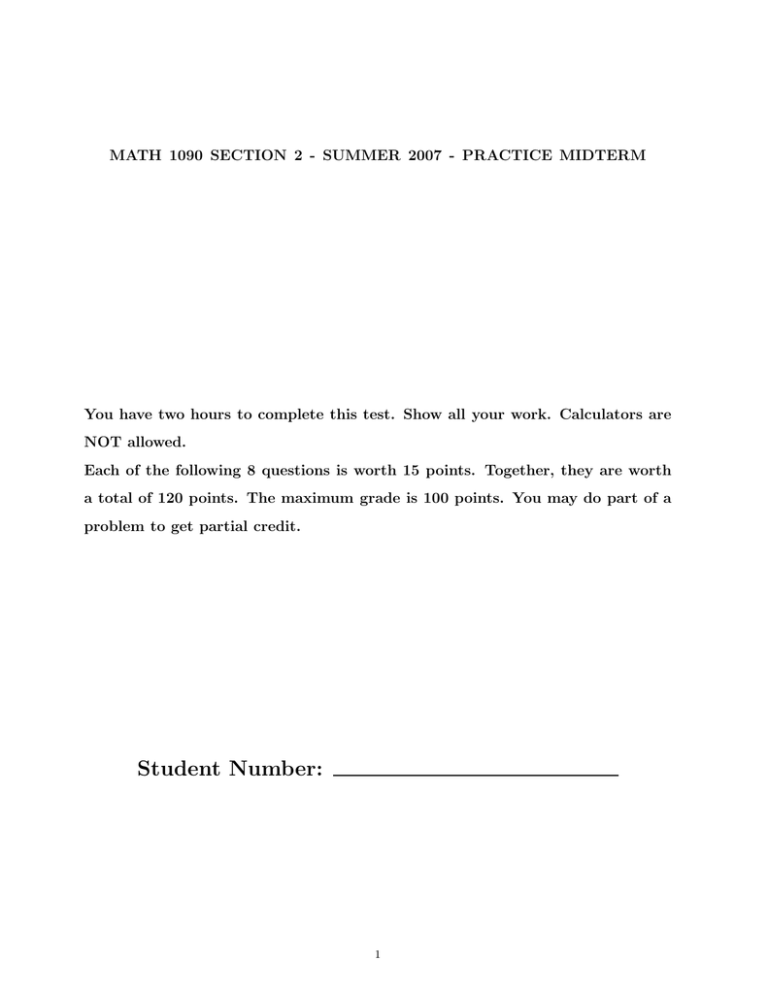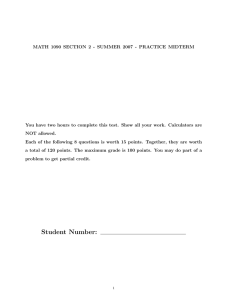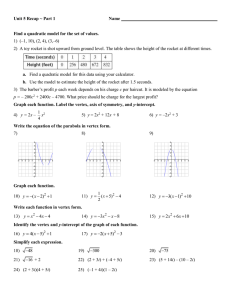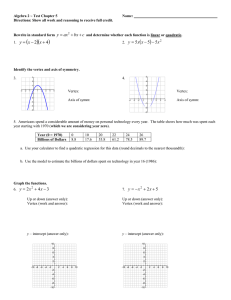MATH 1090 SECTION 2 - SUMMER 2007 - PRACTICE MIDTERM
advertisement

MATH 1090 SECTION 2 - SUMMER 2007 - PRACTICE MIDTERM
You have two hours to complete this test. Show all your work. Calculators are
NOT allowed.
Each of the following 8 questions is worth 15 points. Together, they are worth
a total of 120 points. The maximum grade is 100 points. You may do part of a
problem to get partial credit.
Student Number:
1
(1) Solve:
4
2
6
12
+ = −
x−3 3
5 15 − 5x
Solution:
2
6
12
4
+ = −
x−3 3
5 15 − 5x
12
6 2
4
+
= −
x − 3 15 − 5x
5 3
(1)
Lets simplify the left hand side:
12
4
12
4
+
=
+
x − 3 15 − 5x
x − 3 5(3 − x)
Now (3 − x) = −(x − 3) so:
4
12
20
12
12
8
−
=
−
=
=
x − 3 5(x − 3)
5(x − 3) 5(x − 3)
5(x − 3)
5(x − 3)
Now we’ll work on the right hand side of equation 1:
18 10
8
6 2
− =
−
=
5 3
15 15
15
So equation 1 becomes:
8
8
=
5(x − 3)
15
1
1
=
5(x − 3)
15
1
1
=
x−3
3
3 =x−3
x=6
You can easily check this solution by plugging in to the original equation.
2
(2) Solve:
1 2
x
2
− 32 x +
2
5
=0
Solution:
x1,2 =
But since
4
9
<
−
8
10
2
3
±
q
2
− 23
2 21
−4
1
2
2
5
=
−
2
3
±
q
4
9
1
−
8
10
the expression inside the square root is negative, so there’s no
solution to this equation.
(3) (a) Find the slope-intercept equation of the line which passes through (2, 9) and is
parallel to y = 2x + 1.
Solution: The slope intercept form is: y = ax + b. Since this line is parallel to
y = 2x + 1, then a = 2. It passes through (2, 9) so 9 = 2 · 2 + b. Thus b = 5 and
the equation is y = 2x + 5.
(b) Find the line perpendicular to the line in (3a) and which passes through (5, 2).
Solution: This new line has the form y = cx + d and is perpendicular to
y = 2x + 5. Hence c = − 21 . Since it passes through (5, 2) we get 2 = − 21 5 + d
hence d = 4 21 , and the equation is: y = − 12 x + 4 12 .
(4) The cost per unit depends on the number of units which are manufactured. Suppose
it costs $150 to manufacture 300 units and $160 to manufacture 400 units.
(a) Find the cost per unit in each case.
Solution:
$150 to manufacture 300 units ⇒ the cost per unit is
150
300
= 0.5 dollars per unit.
$160 to manufacture 400 units ⇒ the cost per unit is
160
400
=
4
10
= 0.4 dollars per
unit.
(b) Suppose the cost per unit is a linear function of the number of units manufactured. Find the slope - intercept form of this function.
Solution:
If x=300 units then y=0.5 is the cost per unit.
3
If x=400 units then y=0.4 is the cost per unit.
So the graph of this linear function is a line which passes through (300, 0.5) and
(400, 0.4). The equation corresponding to this line is:
a=
y2 − y1
0.4 − 0.5
−0.1
=
=
= −0.001
x2 − x1
400 − 300
100
We get b by solving:
0.5 = −0.001 · 300 + b
0.5 = −0.3 + b
b = 0.8
So the equation is: y = −0.001 · x + 0.8 and this is also the cost per unit as a
function of the number of units.
(c) Find the cost per unit when 350 units are manufactured.
Solution: Set x = 350 then y = −0.001 · 350 + 0.8 = −0.35 + 0.8 = 0.45 dollars
per unit.
(5) A gas station uses the following demand function: p = 8−0.2x Where x is the number
of (thousands of) gallons sold per day and p is the price per gallon (in dollars). Find
the number of gallons to sell to get a maximum revenue. Find the optimal price per
gallon and the maximum revenue.
Solution:
Let R denote the revenue. Then
R = price · units = (8 − 0.2 · x)x = −0.2x2 + 8x
This parabola opens downward, so the vertex is a maximum for the revenue function.
The coordinates of the vertex:
xv =
−b
−8
−8
=
=
= 20
2a
2 · (−0.2)
−0.4
4
The maximum revenue will be attained when 20 thousands of gallons are sold. The
maximum revenue will be:
Rv = R(xv ) = (8 − 0.2 · 20) · 20 = (8 − 4) · 20 = 4 · 20 = 80
That is 80 thousands of dollars or $80, 000. The price per gallon will be
P = 8 − 0.2 · xv = 8 − 0.2 · 20 = 8 − 4 = 4
dollars per gallon.
(6) A company’s margin of profit is: net income .
net sales
(a) A home business for quilts sold 400 quilts last year at a price of $13 a unit. If z
denotes last year’s net income, express last year’s margin of profit in terms of z.
Solution: Net sales amounts to price times units sold, so:
Ml =
z
400 · 13
(b) This year, the price increased by $2 and still 400 quilts were sold. The net
income grew by $100. Express this year’s margin of profit in terms of z. (Hint:
First write this year’s income in terms of z).
Solution: This year’s net income is z + 100
This year’s price per unit is 13 + 2 = 15
The number of units sold is 400. Therefore:
Mt =
z + 100
400 · 15
(c) Suppose this year’s margin of profit was 4% higher than last year’s. Use (6a)
and (6b) to expresses this.
Solution:
Mt = Ml + 0.04 · Ml = 1.04 · Ml
z + 100
z
= 1.04 ·
400 · 15
400 · 13
5
(d) What was last year’s net profit? What was this year’s net profit?
Solution: Notice that 1.04 =
104
100
=
26
.
25
Now we solve:
z
z + 100
= 1.04 ·
400 · 15
400 · 13
26
z
z + 100
=
·
400 · 15
25 400 · 13
z + 100
2
z
=
·
400 · 15
25 400
2
z + 100
=
·z
15
25
2z
z + 100
=
3
5
5(z + 100) = 6z
5z + 500 = 6z
500 = z
Las year’s net profit was 500 dollars, and this year’s was 600 dollars.
(7) Let f (x) = 2x2 + 2x − 4.
(a) Does it open up or down?
Solution: a > 0 so it opens up.
(b) Find the vertex and write the equation of the axis of symmetry.
= −2
= − 21
Solution: The vertex: xv = −b
2a
4
2
yv = 2 − 21 + 2 − 21 − 4 = 24 − 1 − 4 = −4 21 =
−9
2
The equation of the axis of symmetry is: x = xv = − 12
(c) Find the y-intercept. Find the x-intercepts if they exist.
Solution: y-intercept: Set x = 0 in the equation and get: y = 2·02 +2·0−4 = −4
6
x-intercept: Set y = 0 and solve:
x1,2 =
√
22 − 4 · (2) · (−4)
−2 ± 4 + 32
=
=
2·2
4
√
−2 ± 36
−2 ± 6
=
= 1 or − 2
4
4
−2 ±
p
So the intersection points of the graph with the x axis are: (−2, 0) and (1, 0).
(d) Graph f (x)
2
-2
-1
1
-2
-4
Solution:
(e) What’s the domain of definition of the function h(x) =
Sketch your answer on the real line.
p
√
−f (x) = −2x2 − 2x + 4.
4
2
-1
-2
1
-2
Solution: The graph of −f (x) looks like:
because it is the reflection through the x-axis of the graph of f . y is positive only
when x is between the two intersection points of the graph with the x axis. So
−f (x) is positive only between −2 and 1. So the domain of definition is [−2, 1]
(f) Find the vertex of g(x) = x2 − 9x + 20.
9
2
Solution: The vertex of g is: xv =
−(−9)
2·1
=
yv = ( 29 )2 − 9 · ( 92 ) + 20 =
80
4
81−162+80
4
81
4
−
81
2
+
7
=
= − 41
(g) How would you need to translate (shift) f ’s graph so that it’s vertex would
overlap g’s vertex. What is the function of this new graph?
Solution: f ’s vertex is at (− 21 , − 92 ) and g’s vertex is at ( 92 , − 41 ). So we need to
shift f by 5 to the right and − 41 − (− 92 ) =
17
4
up to make them coincide. To shift
f by 5 to the right get:
f1 (x) = 2(x − 5)2 + 2(x − 5) − 4
To shift f1 up by
17
4
get:
17
f2 (x) = 2(x − 5)2 + 2(x − 5) − 4 +
{z
} 4
|
f1 (x)
(8) Let f (x) =
1
x2
and g(x) = 2x2 + 3x + 5.
(a) What are the functions h(x) = g ◦ f (x) = g(f (x)) and k(x) = f ◦ g(x) = f (g(x))
do not simplify your answer. Is h(1) = k(1)?
Solution:
h(x) = g(f (x)) = g
1
x2
=2
1
x2
2
1
+3
x2
+5
and h(1) = 2 112 + 3 112 + 5 = 10
k(x) = f (g(x)) = f (2x2 + 3x + 5) =
and k(1) =
1
(2·12 +3·1+5)2
=
1
10
1
(2x2 + 3x + 5)2
so h(1) 6= k(1)
(b) What is f (x + h)? What is the difference quotient? D1 (x, h) =
f (x+h)−f (x)
?
h
do
not simplify your answer.
Solution: f (x + h) =
1
(x+h)2
and
f (x + h) − f (x)
D1 (x, h) =
=
h
1
(x+h)2
h
−
1
x2
(c) What is g(x + h)? What is the difference quotient? D2 (x, h) =
g(x+h)−g(x)
?
h
Simplify your answers.
Solution: g(x + h) = 2(x + h)2 + 3(x + h) + 5 = 2(x2 + 2xh + h2 ) + 3(x + h) + 5 =
2x2 + 3x + 5 + 2xh + h2 and
8
Dg (x, h) =
g(x + h) − g(x)
2x2 + 3x + 5 + 2xh + h2 − (2x2 + 3x + 5)
2xh + h2
=
=
=
h
h
h
h(2x + h)
= 2x + h
h
9








